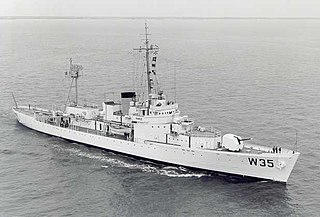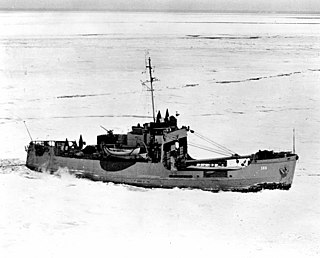
The Silver Star Medal (SSM) is the United States Armed Forces' third-highest military decoration for valor in combat. The Silver Star Medal is awarded primarily to members of the United States Armed Forces for gallantry in action against an enemy of the United States.
The Commendation Medal is a mid-level United States military decoration presented for sustained acts of heroism or meritorious service. Each branch of the United States Armed Forces issues its own version of the Commendation Medal, with a fifth version existing for acts of joint military service performed under the Department of Defense.

The Navy Unit Commendation (NUC) is a United States Navy and United States Coast Guard unit award that was established by order of the Secretary of the Navy James Forrestal on 18 December 1944.

The United States Revenue Cutter Service was established by an act of Congress on 4 August 1790 as the Revenue-Marine upon the recommendation of Secretary of the Treasury Alexander Hamilton to serve as an armed customs enforcement service. As time passed, the service gradually gained missions either voluntarily or by legislation, including those of a military nature. It was generally referred to as the Revenue-Marine until 31 July 1894, when it was officially renamed the Revenue Cutter Service. The Revenue Cutter Service operated under the authority of the U.S. Department of the Treasury. On 28 January 1915, the service was merged by an act of Congress with the United States Life-Saving Service to form the United States Coast Guard.
The Meritorious Unit Commendation is a mid-level unit award of the United States Armed Forces. The U.S. Army awards units the Army MUC for exceptionally meritorious conduct in performance of outstanding achievement or service in combat or non-combat, the U.S. Navy and U.S. Marine Corps award units the Navy MUC for valorous or meritorious achievement or service in combat or non-combat, and the U.S. Coast Guard awards units the Coast Guard MUC for valorous or meritorious achievement or service not involving combat.

The United States Armed Forces awards and decorations are primarily the medals, service ribbons, and specific badges which recognize military service and personal accomplishments while a member of the U.S. Armed Forces. Such awards are a means to outwardly display the highlights of a service member's career.

The United States Coast Guard Auxiliary is the uniformed civilian volunteer force, acting as an auxiliary force multiplier for the United States Coast Guard. Congress established the unit on 23 June 1939, as the United States Coast Guard Reserve. On February 19, 1941, the entity was renamed the United States Coast Guard Auxiliary. The Auxiliary's purpose is to bolster all USCG undertakings both at sea and in the sky, with the exception of tasks necessitating "direct" law enforcement or military actions. As of 2022, the U.S. Coast Guard Auxiliary boasted around 21,000 members.
The Achievement Medal is a military decoration of the United States Armed Forces. The Achievement Medal was first proposed as a means to recognize outstanding achievement or meritorious service of military personnel who were not eligible to receive the higher Commendation Medal or the Meritorious Service Medal.
A "V" device is a metal 1⁄4-inch (6.4 mm) capital letter "V" with serifs which, when worn on certain decorations awarded by the United States Armed Forces, distinguishes an award for heroism or valor in combat instead of for meritorious service or achievement.
The Operational Distinguishing Device is a miniature silver 5⁄16 inch letter "O" that is authorized by the United States Coast Guard as a ribbon device which may be authorized for wear on certain awards and decorations of the United States Coast Guard.
The Coast Guard Unit Commendation is the highest peacetime unit award that may be awarded to military commands of the United States Coast Guard. The decoration was first created in 1963 and is presented to members of any Coast Guard unit that distinguishes itself by valorous or extremely meritorious service, not involving combat, but in support of Coast Guard operations.
The Commandant's Letter of Commendation Ribbon is a personal military award of the United States Coast Guard. The award was established in March 1979 by Admiral John B. Hayes.

USCGC Ingham (WPG/WAGC/WHEC-35) is one of only two preserved Treasury-class United States Coast Guard Cutters. Originally Samuel D. Ingham, she was the fourth cutter to be named for Treasury Secretary Samuel D. Ingham. She was the most decorated vessel in the Coast Guard fleet and was the only cutter to ever be awarded two Presidential Unit Citations.
The Special Operations Service Ribbon is a service award of the United States Coast Guard which was first created 1 July 1987 by order of Commandant of the Coast Guard, Admiral Paul A. Yost Jr. The award is authorized for certain acts of non-combat meritorious service, for which no other service medal or ribbon is authorized.

USCGC Tamaroa (WAT/WMEC-166), originally the United States Navy Cherokee-class fleet tugUSS Zuni (ATF-95), was a United States Coast Guard cutter. Following the U.S. Coast Guard custom of naming cutters in this class of ship after Native American tribes, she was named after the Tamaroa tribe of the Illiniwek tribal group.

United States law enforcement decorations are awarded by the police forces of the United States of America. Since the United States has a decentralized police force, with separate independent departments existing on the state and local level, there are thousands of law enforcement decorations in existence.

USCGC Dallas (WHEC-716) was a United States Coast Guard high endurance cutter commissioned in 1967 at the Avondale Shipyard in New Orleans, Louisiana. She was the sixth ship or boat to bear the name of Alexander J. Dallas, the Secretary of the Treasury under President James Madison (1814–1816). She is one of twelve Hamilton-class cutters built for the Coast Guard.

USCGC Forward (WMEC-911) is a United States Coast Guard medium endurance cutter. Named for Walter Forward, fifteenth United States Secretary of the Treasury, she was constructed by Robert Derecktor Shipyard Incorporated, Middletown, Rhode Island was delivered in May 1989, and commissioned 4 August 1990. USCGC Forward (WMEC-911) and USCGC Legare (WMEC-912) were commissioned in a joint ceremony in Portsmouth, Virginia.

Ronald James Rábago is a retired United States Coast Guard rear admiral who in 2006 became the first person of Hispanic American descent to be promoted to flag rank in the United States Coast Guard. He retired as the assistant commandant for engineering and logistics and the United States Coast Guard's chief engineer in 2014.

USCGC Basswood (WLB-388) was an Iris-class buoy tender belonging to the United States Coast Guard launched on 20 May 1943, and commissioned on 12 January 1944.












